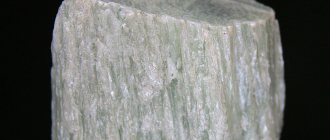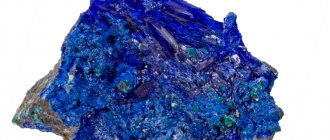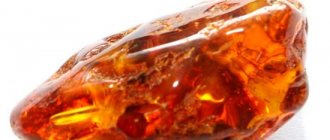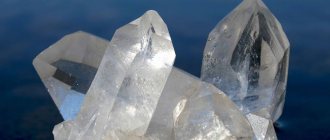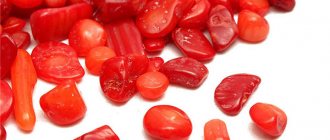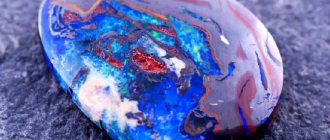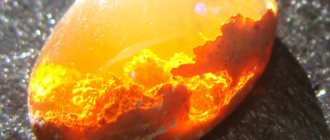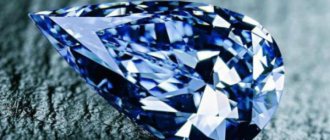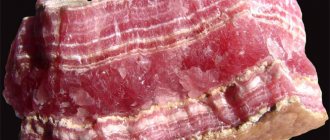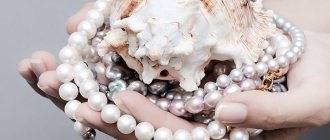| Category | Phosphates (minerals) |
| Title in English | Apatite |
| Formula | Ca5[PO4]3 |
| Group | Mineral group |
| Color | White, Green, Blue-green, Light Blue, Purple, Red |
| Stroke color | White to yellowish gray |
| Shine | Glassy to greasy |
| Transparency | Transparent, Translucent to Opaque |
| singonia | Hexagonal |
| Hardness | 5 |
| Cleavage | Imperfect |
| Density, g/cm³ | 3,2 — 3,4 |
| Kink | Conchoidal |
| origin of name | Apatite is a derived name from the Greek word ἀπατάω, which translates as “deception.” Such an interesting name was given due to the fact that the semi-precious stone can easily be confused with amethyst, tourmaline, topaz, beryl or diopside. |
| Morphology | The most common form of apatite occurs as prismatic, pre-acicular crystals. However, tabular forms are also noted. |
The geological concept of “blende” is associated with rocks that imitate various nuggets. One of these “ardent deceivers” is apatite, as even the name of this mineral indicates. It contains calcium phosphate and pure calcium, which together form beautiful and regular geometric crystals of large sizes, similar to precious gems. Apatite aggregates can weigh hundreds of kilograms! But not all stones are suitable for jewelry. Small transparent crystals are considered the highest quality. And only a few of them are pure enough and suitable for cutting and making jewelry.
Apatite deposits
Large deposits of apatite are rare.
The largest known one is located on the Kola Peninsula (Russia), where there are deposits of apatite ore that contain fluorapatite and nepheline (apatite nepheline ores). Large apatite crystals (moroxites) are mined in Transbaikalia. — Advertising —
In addition, apatite is mined in countries such as Brazil, Mexico, USA, Chile, South Africa, Finland, Spain, and Norway.
Questions/Answers
Ask, ask questions. We are in touch and ready to answer.
How to distinguish a fake?
Apatite is an inexpensive stone and is rarely counterfeited. Usually glass or plastic is used for this.
Therefore, we recognize a fake:
- By hardness . Plastic and apatite are easily scratched with a needle.
- According to the thermal conductivity test . Natural stone will remain cool in the palm of your hand much longer than plastic.
Natural apatites are extremely rare without internal inclusions. So if they offer an apatite crystal of uniform color, there is a reason to check the stone.
For your information: if you decide to buy beryl, tourmaline or topaz, they may try to sell you apatite as a fake. Even geologists confused minerals with these precious gems.
How to care?
Carefully. The stone has low hardness and is easy to scratch.
Basic principles of care:
- Keep the jewelry in a separate case.
- Do not allow impacts on hard surfaces or falls.
- Protect from prolonged exposure to ultraviolet radiation.
- Avoid steam and ultrasonic cleaning.
We wash the contaminated stone with a weak soap solution using a soft cloth, rinse with water, and dry with a dry natural cloth.
Who should wear it?
For people in dangerous professions:
- military;
- firefighters;
- pilots;
- sailors;
- policeman.
You need to wear a pendant or beads so that the gem touches the skin. Before danger arises, the stone will “burn” the skin. This is a gem warning. Do not remove the talisman jewelry. It’s better to think about where trouble might come from.
How to wear?
So that the stone touches the skin. These are beads, pendants, pendants, necklaces.
Inserts in earrings and especially in rings do not work for protective purposes and are impractical for “exploitation”.
What is the price?
The price of crystals depends on their quality. Color, transparency, availability affect the cost of the gem.
- Blue and green commercial quality crystals from Madagascar - from $10 to $40.
- Blue and green crystals of the highest quality from Madagascar - up to $160.
- Yellow ones from Madagascar - from 10 to 60 $.
- Purple from Namibia - from 200 to 800 $.
Blue apatites are easy to buy, but yellow ones will have to be found.
What colors are there?
Different. This:
- blue;
- blue;
- violet;
- blue-green;
- yellow;
- white;
- very rarely pink (reddish).
Depending on the color and impurities, some have their own names.
Where can I buy?
The stone is relatively inexpensive. This can be ordered in an online store, bought at a gem fair, or in jewelry stores.
These stones cannot be found at pretentious jewelry auctions.
What stones does it go with?
With rock crystal, with aquamarine. Even with diamonds.
How was apatite found in Russia?
In Russia, the stone was discovered by accident. Fersman's expedition in 1921 studied the Khibiny Mountains. Astrophyllite and sphene were discovered, and a new mineral, yuksporite, was discovered. And on Mount Kukisvumchorr, as Fersman wrote, “they found a large number of green blocks of apatite layered rock.”
By the way, geologists have a very difficult time.
It was bad with clothes and shoes. Fersman wrote in his notes: “Rope shoes with a tarpaulin lining are better than those wrapped in foot wraps.”
Food on this expedition consisted of millet porridge and collected mushrooms and berries.
The expedition members carried the equipment on themselves. The Sami guides did not carry loads on themselves. And the collected collections of minerals were loaded onto sleighs of reindeer.
Where to look for apatity in Russia?
Back in the Union, geological expeditions discovered:
- In Transbaikalia and the Kola Peninsula there are blue and cyan crystals.
- On Aldan - green.
- In the Pamirs and Eastern Transbaikalia there are pink, smoky and white crystals.
What is apatite called abroad?
In 2010, IMA optimized apatite nomenclatures.
The apatite supergroup was divided into 5 groups:
- Apatity.
- Britholites.
- Gedifans.
- Ellestadites.
- Belovity.
Therefore, the term apatite is not officially the name for the mineral. This is the name of a supergroup of minerals.
History of apatite
The first scientific description of apatites was made at the end of the 18th century by the scientist A.G. Werner, who proposed a name for the stone. The word “apatite” is of ancient Greek origin and is translated as “I deceive.” It indicates that natural apatite is extremely diverse and can superficially resemble other stones, such as beryl, diopside and tourmaline. A diagnostic feature of apatite is the prismatic shape of its crystals and relatively low hardness.
Description
Official descriptions of the stone are published in geological reference books. Apatites are a large mineral group of varieties that are close to each other in chemical components. They consist of calcium phosphate and impurities that determine the shade of the specimen. Pure ones are almost colorless. The blue tint is explained by manganese, lead, yellow - by iron.
Apatite looks attractive in photos, but in real life it is even more beautiful due to its luminescent qualities. The color of the specimen varies somewhat, depending on the lighting angle and viewing angle.
The rock is practically not used in the jewelry industry due to its low hardness.
This is a stone of manifestation. It symbolizes service to goodness, love for people, personifies the future and the past. The breed stimulates human qualities, abilities, personal and spiritual growth. Useful for meditation and self-expression.
Apatite - ornamental stone
Physico-chemical characteristics of apatite
In terms of their chemical composition, apatites belong to mixed calcium phosphates.
As additional elements, apatite often contains fluorine, chlorine, manganese, iron, strontium, aluminum, thorium, and rare earth elements. — Advertising —
The shape of the mineral crystals is varied: from prismatic to needle-shaped, less often short-columnar or tabular. Apatites are characterized by the presence of granular sugar-like aggregates, dense masses, radial and columnar aggregates. The fine-fiber structure is much less common.
Pure apatite crystals are colorless, completely transparent or translucent. Their color depends on the composition of impurities, for example, iron gives the mineral a smoky or yellowish tone, blue and green apatites contain manganese and lead.
The gem is characterized by the manifestation of luminescence, due to which it changes its color from different viewing angles. Blue and yellow examples are often decorated with a cat's eye effect.
The hardness of apatite on the Mohs scale is 5, which is quite low for jewelry processing and requires careful handling of the stone.
Who is it suitable for?
By color:
Blue - for readers, teachers, singers. For those whose throat is constantly under increased stress;
Yellow - businessmen, business people; those who lack assertiveness and “impudence” in their character.
Blue - for humanists;
Astrologers advise
For medicinal and protective purposes it is suitable for any zodiac sign.
Will quickly get used to Aries, Leo, Scorpio.
The gem gets used to any owner very quickly.
Expert opinion
Semenishcheva Polina
Specialist in mineralogy. Graduated from St. Petersburg Mining University.
Please note : do not give a stone that has already been worn; without you, it will not only die energetically, but will also cause harm to the new owner.
Element
Depending on the color of the crystal.
Water
Earth
Air
Fire
Planets
Corresponds to the elements of crystal.
Energy
Receptive Yin
Magical properties of apatite
All owners of jewelry and talismans with apatite are guaranteed to prevent serious upheavals in life.
This gem causes prophetic dreams to appear; it endows its owner with insight and a strong intuitive awareness of dangerous situations. Interestingly, if the stone is worn on the body, it begins to behave very actively. For example, when danger approaches, the skin that comes into contact with the stone begins to become irritated, itchy and red. And if at the same time there is a desire to get rid of the decoration, it means that the danger has reached its maximum. Still, it’s not worth parting with apatite. It is believed that when a stone is separated from its owner, it loses all its properties and becomes a dull and colorless piece of rock.
But apatite cannot damage, so it has never been used in black magic rituals.
Stone with a riddle
A gem with a radiant shine has a positive effect on a person and acts as an indicator of health.
The crystal miraculously recognizes the cause of the disease and indicates this by fading of color. Apatite very faithfully protects its owner from the approach of trouble and begins to cause discomfort with itching and burning on the skin. But you can’t get rid of it, because it simply solves its owner’s problem, absorbing all the negativity. From its excess, the mineral can crack. Such a talisman must be removed, thrown into the river or buried in the ground. And instead of a damaged one, you should purchase a new talisman. Being under the owner's pillow at night, he can send prophetic dreams that will indicate the cause of the problem. If you need to remove a stone, you should put it in your pocket or bag.
Healing properties of apatite
For the healing properties of apatite to manifest, it must be combined with other healing minerals.
For example, crystals of yellow and brown shades in combination with other similar minerals stimulate the heart, and if blue apatites are combined with aquamarines, they will help a lecturer or singer. The harmonization of the human condition is facilitated by the combination of intensely blue apatites with jewelry made of rock crystal and diamonds.
With the help of green apatites, depression and depressed states are treated. Blue-green crystals have a calming and peaceful effect.
Decorations
Apatite beads
Due to the fact that the stone is not durable enough, it is recommended to use it only for those precious jewelry that are not intended for frequent wear.
For example, it could be a necklace, cufflinks or earrings. Apatite earrings will definitely relieve the owner from headaches.
As a rule, it is not suitable for rings and bracelets, since there is a risk of frequent impacts, due to which the mineral may crumble. But such decorations still exist.
There is even an opinion that the ring strengthens tooth enamel, and the bracelet will help get rid of osteoporosis. As a rule, such products are framed with silver or cupronickel.
In addition, specimens of about 5 carats are suitable for jewelry making and are very rarely found up to 20. It is also noteworthy that the most valuable stones for jewelers are yellow and blue.
Unusual figured souvenirs are made from cracked minerals that have an original look.
Photo gallery of jewelry:
Applications of apatite
Non-gem quality apatite is a raw material in the production of phosphate fertilizers, phosphorus compounds and phosphate acid.
The mineral is used in ferrous and non-ferrous metallurgy, for the production of ceramics and glass. Jewelers use apatite quite rarely, which is due to its low hardness and fragility. Typically, gem-quality apatites barely reach 5 carats, and extremely rarely – 20 carats. As a rule, such samples are an object of collector's interest, especially if they are well cut, translucent and transparent.
Use in agriculture
It has long been known that apatites are fertility minerals, so their main area of application is agriculture. Phosphorus is one of the main components of a chemical compound, as mentioned above. As you know, this element is vital not only for humans, but also for plants. Phosphorus is a building material for living organisms; it takes part in many biological processes.
Apatites are minerals that are the starting product for the production of natural mineral phosphorus fertilizers. Raw materials have been used for this purpose for a very long time. Since the beginning of the 20th century, many mineral processing plants have been built and are operating. One of the largest is the Khibiny Apatit plant, which was put into operation in 1929 on the basis of the world’s largest deposit.
How to distinguish real apatite from a fake
Apatite itself is not counterfeited, but the gem itself, even the name of which is translated as “deception,” is quite often confused with tourmalines, topazes, beryls, amethysts, diopsides and aquamarines. The main difference between apatite and precious and semi-precious stones is its low hardness.
How to care for apatite
Like all relatively soft and fragile stones, apatite needs to be treated very carefully, protected from mechanical influences, shocks and scratches.
Jewelry with apatite should not be left exposed to direct sunlight for a long time. Clean apatite using a damp soft cloth.
Prices for apatite products
Considering the varied properties and quality of apatites, their prices also vary widely. For example, transparent, clean samples with a beautiful cut are valued at $2-3 per carat. Heterogeneous stones with defects are valued much lower. Beads are often made from them. The cheapest specimens of apatite are those that are ground into cabochons. Such stones are opaque and layered. Pendants and other small jewelry are made from fractured apatites, the cost of which is very low.
Jewelry and more
Jewelry crystals are a pleasant addition to the huge amount of apatite that humanity uses.
Widely used in industry:
- textile;
- chemical;
- food;
- metallurgical;
- military;
- ceramic.
Expert opinion
Semenishcheva Polina
Specialist in mineralogy. Graduated from St. Petersburg Mining University.
“Bread stone” is the second name for a useful mineral. It is used to make superphosphate, a fertilizer that has helped grow bread for years.
